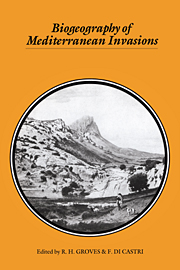Book contents
- Frontmatter
- Contents
- List of contributors
- Preface
- Part I Introduction
- Part II Historical background
- Part III Biogeography of taxa
- 7 Invasive plants of the Mediterranean Basin
- 8 Invasive vascular plants of California
- 9 Introduction of plants into the mediterranean-type climate area of Chile
- 10 Introduced plants of the fynbos biome of South Africa
- 11 Invasive plants of southern Australia
- 12 Life cycles of some Mediterranean invasive plants
- 13 Invasion processes as related to succession and disturbance
- 14 Is fire an agent favouring plant invasions?
- 15 Plant invasion and soil seed banks: control by water and nutrients
- 16 Invasion by annual brome grasses: a case study challenging the homoclime approach to invasions
- 17 Patterns of Pleistocene turnover, current distribution and speciation among Mediterranean mammals
- 18 Introduced mammals in California
- 19 Ecology of a successful invader: the European rabbit in central Chile
- 20 Mammals introduced to the mediterranean region of South Africa
- 21 Mammals introduced to southern Australia
- 22 Invasions and range modifications of birds in the Mediterranean Basin
- 23 Invasions in the mediterranean avifaunas of California and Chile
- 24 Birds introduced to the fynbos biome of South Africa
- 25 Species of introduced birds in mediterranean Australia
- Part IV Applied aspects of mediterranean invasions
- Part V Overview
- Index of scientific names
- Subject index
24 - Birds introduced to the fynbos biome of South Africa
Published online by Cambridge University Press: 02 December 2009
- Frontmatter
- Contents
- List of contributors
- Preface
- Part I Introduction
- Part II Historical background
- Part III Biogeography of taxa
- 7 Invasive plants of the Mediterranean Basin
- 8 Invasive vascular plants of California
- 9 Introduction of plants into the mediterranean-type climate area of Chile
- 10 Introduced plants of the fynbos biome of South Africa
- 11 Invasive plants of southern Australia
- 12 Life cycles of some Mediterranean invasive plants
- 13 Invasion processes as related to succession and disturbance
- 14 Is fire an agent favouring plant invasions?
- 15 Plant invasion and soil seed banks: control by water and nutrients
- 16 Invasion by annual brome grasses: a case study challenging the homoclime approach to invasions
- 17 Patterns of Pleistocene turnover, current distribution and speciation among Mediterranean mammals
- 18 Introduced mammals in California
- 19 Ecology of a successful invader: the European rabbit in central Chile
- 20 Mammals introduced to the mediterranean region of South Africa
- 21 Mammals introduced to southern Australia
- 22 Invasions and range modifications of birds in the Mediterranean Basin
- 23 Invasions in the mediterranean avifaunas of California and Chile
- 24 Birds introduced to the fynbos biome of South Africa
- 25 Species of introduced birds in mediterranean Australia
- Part IV Applied aspects of mediterranean invasions
- Part V Overview
- Index of scientific names
- Subject index
Summary
No bird species native to another continent occurs regularly or normally in intact fynbos vegetation, whether lowland or montane. Several introduced species (summarised in Table 24.1) occur in disturbed and human-modified environments in the fynbos biome. Introduced birds were reviewed recently for South Africa as a whole (Brooke et al., 1986) and unreferenced statements made below are based on that earlier review: major references are cited in this review, however. This chapter covers much the same ground as Brooke et al. (1986) but only in respect of the fynbos biome because of its predominance in the mediterraneanclimate area of South Africa. This chapter focuses on the impacts, if any, on fynbos vegetation. Escaped cage and aviary birds which have not bred in the wild are of little importance ecologically and are not normally observed in the fynbos biome.
The introduced bird with the greatest probable biomass in the fynbos biome is the helmeted guinea-fowl Numida meleagris, deliberately introduced to improve sport-shooting at the end of the last century (Skead, 1962). The source was N. m. coronata which is indigenous to the eastern Cape region of South Africa. Domestic guineafowl were, and to some extent still are, widely kept on farms and these are derived from West African N. m. galeata. Domestic and wild birds interbreed freely and a minority of wild birds show the pallid colouring derived from domestic populations.
- Type
- Chapter
- Information
- Biogeography of Mediterranean Invasions , pp. 359 - 364Publisher: Cambridge University PressPrint publication year: 1991
- 4
- Cited by

